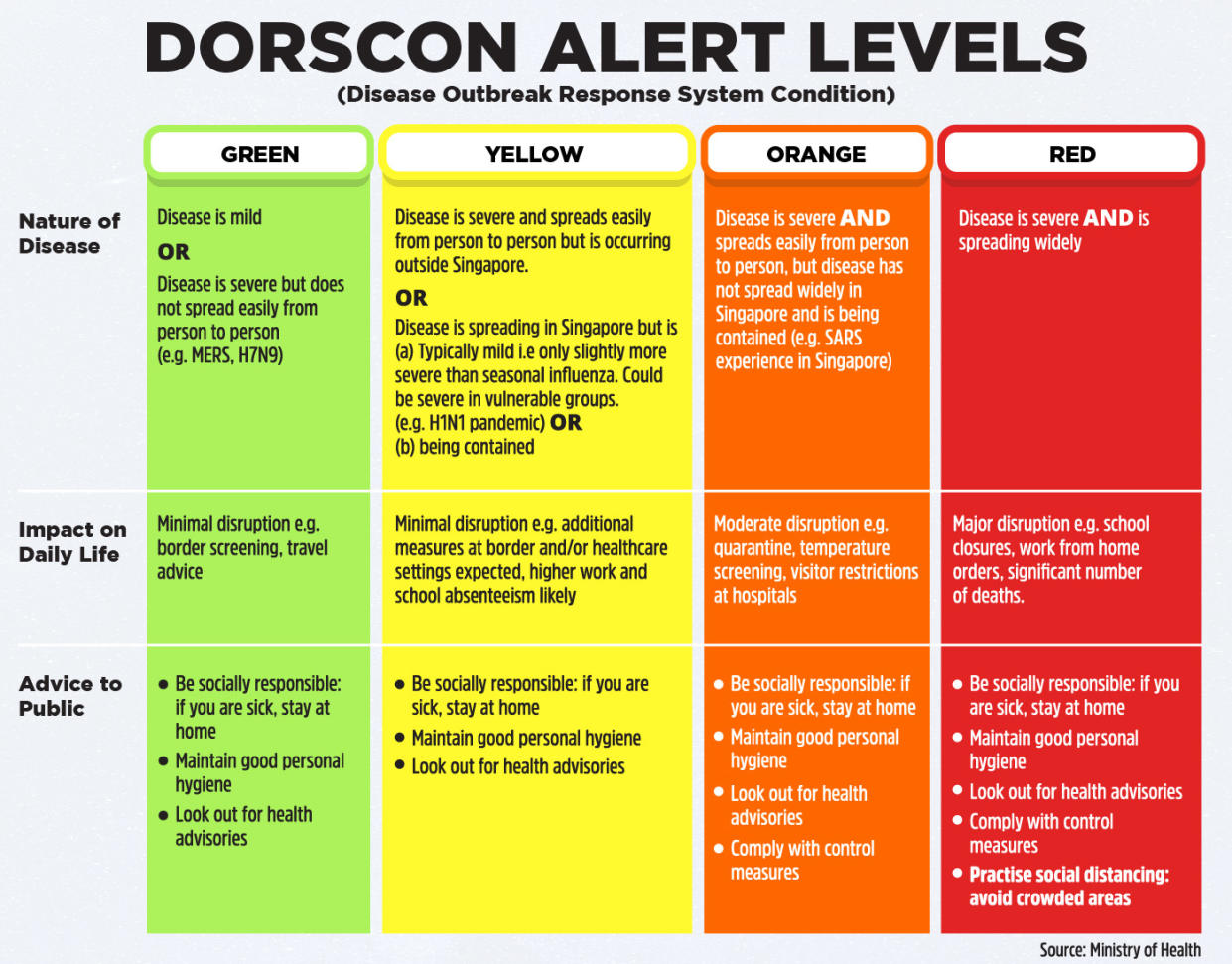Coronavirus: Singapore raises Dorscon response level to ‘orange’

SINGAPORE — The Singapore government on Friday (7 February) raised the disease outbreak response level to “orange” from “yellow” amid an increase in the number of confirmed cases of the novel coronavirus (2019-nCoV) in the Republic.
Authorities also revealed three new confirmed cases as of Friday. These cases and one other case have no links to previous cases or travel history to China.
The announcement was made during a media briefing by Lawrence Wong, the co-chair of the multi-ministry taskforce on the novel coronavirus and National Development Minister.
Under the “orange” level of the Disease Outbreak Response System Condition (Dorscon), a disease is considered to be severe and spreads easily from person to person, but the disease has not spread widely in Singapore and is contained. During the SARS epidemic in 2003, the Republic was also at a similar alert level.
“We have planned for such a scenario involving community spread. Since last month, the government has implemented a series of defensive measures to reduce the risk of imported cases and community transmission. We have strengthened these measures progressively as the situation escalated, both globally and in Singapore,” MOH said in a statement.
Addressing reporters at a media briefing on Friday, taskforce co-chair and Health Minister Gan Kim Yong warned that the situation may take weeks or even months to resolve. “I understand that Singaporeans are anxious, concerned. There is much that we do not yet know about the virus...But life cannot come to a standstill.”
Nevertheless, authorities have unveiled several additional precautionary measures to minimise the risk of further transmission across Singapore.
Large-scale events
Event organisers are advised to cancel or defer non-essential large-scale events. Should the events proceed, the organisers should carry out precautions such as temperature screening, looking out for respiratory symptoms, reminding participants not to attend if they have recent travel history to mainland China and requiring travel declaration, and stepping up cleaning of commonly used areas.
Individuals who are unwell, on Leave of Absence, or have recent travel history to mainland China should not attend such events.
Measures for workplaces and hospitals
Employers should require their employees to conduct temperature-taking at least twice a day and check whether they have respiratory symptoms such as cough and runny nose. Anyone with a fever or is unwell should leave office immediately to see a doctor.
All workplaces should step up their business continuity plans including allowing for employees to telecommute or dividing the workforce into segregated teams.
MOH will be implementing temperature screening and closer controls of entry points into hospitals. Among them, patients with pneumonia will be cared for separately from other patients to reduce the risk of transmission.
Measures for schools
With immediate effect, schools will suspend inter-school and external activities till the end of March school holidays including national school games, learning journeys and camps. Schools and teachers will continue to implement the measures announced on Tuesday such as classroom-based assemblies, school-based co-curricular activities in smaller groups and staggered recesses.
Preschools and social/eldercare services will limit the number of visitors to their premises.
Lawrence Wong warned that, despite the government’s best efforts to ring-fence the disease, there may still be wider community spread. “If the situation worsens, we may well have to take more stringent measures beyond what we are announcing today.”
But he also noted that while the mortality rate in China is 2 per cent, it remains at 0.2 per cent outside of Hubei province: much lower than SARS. “If the mortality rate remains low or even continues to fall further, depending on the evidence and depending on how it evolves, then I think we are dealing with something quite different and we may well have to consider a different approach.
“Meanwhile, for now, I think all of us will have to do our part to stay vigilant, to keep our guards up and carry on with our lives.”
Dorscon takes into account the current disease situation overseas, how transmissible the disease is, how likely it is to arrive in Singapore, and what impact it may have on Singapore’s community.
As of Friday, there are 33 confirmed cases of the coronavirus, including one local transmission cluster.
Outside of mainland China, there has been one death reported in Hong Kong and another in the Philippines.
The number of countries and territories reporting confirmed cases has risen to 27.
As of Friday, the death toll in China has increased to 636, with 73 new deaths reported. Of the 73 deaths, 69 cases were reported from Hubei province, the epicentre of the outbreak, including 64 in the provincial capital Wuhan.

Stay in the know on-the-go: Join Yahoo Singapore's Telegram channel at http://t.me/YahooSingapore
Related stories:
Coronavirus: 3 new unlinked cases in S'pore including VJC teacher; total at 33
Coronavirus: Schools to suspend inter-school, external activities until end of March school holidays
Coronavirus: Don't shake hands, adopt alternative greetings, says Ministry of Health
Coronavirus: Employers must inform MOM of workers returning to Singapore from China – Lawrence Wong
Coronavirus outbreak's impact on Singapore aviation sector will be bigger than SARS: Khaw



